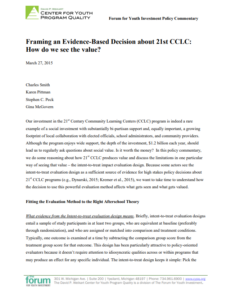Summary
In this commentary we’ve described a mismatch between the afterschool theory of change and the intent-to-treat evaluation design, suggesting that when these powerful evaluation designs are applied to broad developmentally focused programs such as 21st CCLC, the effect sizes are likely to be small but substantively important. We’ve also suggested that afterschool evaluations need to include description and measurement of critical program qualities and the specific skills these programs are focused on growing. An example of a 21st CCLC evaluation which combines both an intent-to-treat impact design with a substantial effort to understand how all of the pieces fit together is the Texas 21st CCLC Year 2 Interim Evaluation Report. We further suggested that 21st Century has intentionally fostered an important social innovation, the afterschool QIS. Because 21st CCLC represents ethic of accountability for service quality in many states, the program has also sparked a broader social movement that has improved the state of afterschool for all American youth.
